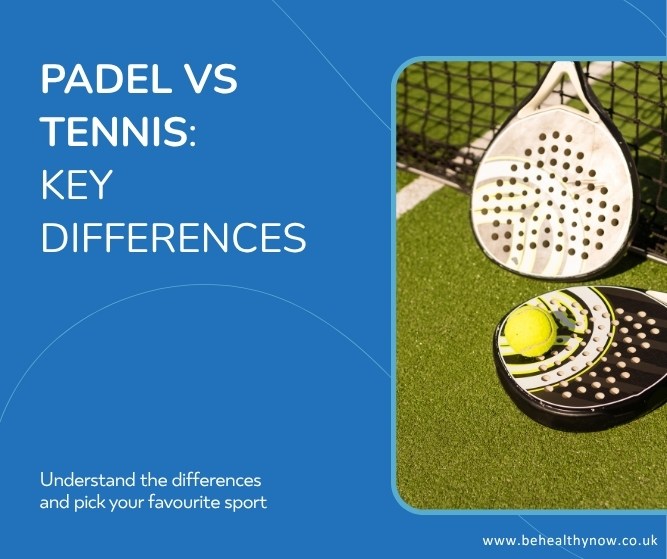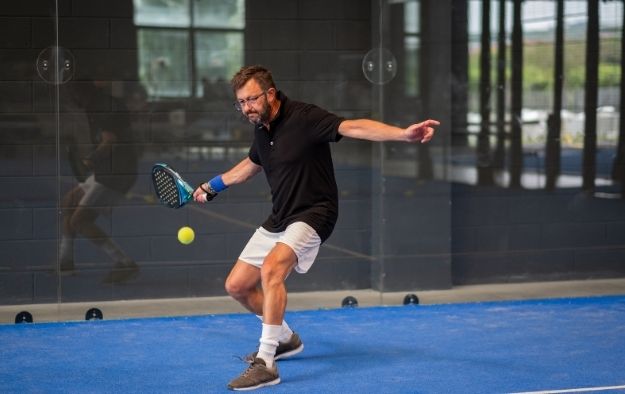
If you’ve ever seen padel and tennis side by side, you might think they’re pretty similar—rackets, nets, balls, and plenty of running. But in reality, these two sports feel very different once you step on court. From the size of the playing area to the way the ball bounces, padel and tennis each have their own personality. Let’s break down what sets them apart and help you figure out which game might be your perfect match.
Where It All Began
Tennis has been around for centuries, but padel is the new kid on the block. It started in 1969 in Acapulco, Mexico, when Enrique Corcuera built a small tennis-like court in his backyard and surrounded it with walls so the ball wouldn’t fly into his neighbour’s yard. A Spanish friend tried it, loved it, and brought it back to Marbella. From there, padel spread across Spain, into Argentina, and now it’s appearing in clubs, parks, and even rooftop courts around the world.

Court Size and Design
The most obvious difference is the court itself. A padel court is much smaller—just 10 by 20 metres—and completely enclosed by glass or mesh walls. These walls aren’t just for decoration; they keep the ball in play and create unique rebound shots. A tennis court, by contrast, is larger and open, measuring 23.77 metres long and 8.23 metres wide for singles (10.97 metres for doubles), with no walls to bring the ball back.
This changes the way you move. In padel, you cover less ground, using quick side-steps and reacting to rebounds. In tennis, you’ll run longer distances and rely on big groundstrokes. The net is also slightly lower in padel, which makes shots a bit easier to clear.

Balls: Same Size, Different Feel
Padel balls look exactly like tennis balls, but they have lower internal pressure. That means they bounce a little less and slow down faster after hitting the court. This softer bounce helps extend rallies, especially for beginners, and reduces the amount of time you spend chasing stray balls. In tennis, the higher-pressure ball is livelier, which rewards power and topspin—but can also send shots sailing out more easily.
Rackets and Bats
Pick up a padel bat and you’ll immediately notice it’s different from a tennis racquet. A padel bat has no strings—it’s a solid, foam-filled paddle with holes drilled through it. This design gives a flatter, more controlled pop when you hit the ball. It’s slightly heavier than many tennis racquets, but shorter, which makes it easier to handle in tight spaces.
Tennis racquets, on the other hand, have a strung frame that “pockets” the ball before releasing it, allowing for more spin and speed. The longer handle also gives space for a two-handed backhand, while padel bats are designed for one-handed strokes.

Shoes and Surfaces
Padel is played on synthetic turf sprinkled with sand, which means the right shoes need a tread that grips the sand but still allows for controlled sliding. Most padel shoes use a deep herringbone or hybrid pattern. Tennis, depending on the surface—hard, clay, or grass—requires different outsoles. Clay-court tennis shoes work well for padel, but hard-court shoes can grip too much, making movement awkward on the sand.
Serving and Rallying
The serve is another big difference. In padel, you serve underarm, hitting the ball below your waist after a bounce. This makes the serve easier to return and keeps rallies going. In tennis, serves are overarm and can be extremely powerful—often winning the point outright.
Padel is also doubles-only, meaning there are always four players on the court. This creates a social, teamwork-focused game. Tennis can be played as singles or doubles, with singles generally being faster and more physically demanding.
Because of the smaller court, softer ball, and live walls, padel rallies tend to last longer—often 9 shots or more—while tennis points can be over in just a few strokes, especially on faster surfaces.
Scoring
The scoring system is nearly identical: 0–15–30–40–game. But padel often uses a “golden point” at deuce—one rally decides the game—while tennis requires a two-point lead. Padel matches are best of three sets, and since they’re always doubles, teamwork is key.
Learning Curve
If you’re completely new to racket sports, padel is usually easier to pick up. The smaller court, softer serve, and forgiving walls mean you’ll enjoy rallies almost immediately. Tennis takes more time to master, with its bigger court, faster ball, and greater variety of strokes. But once you get comfortable, tennis offers more opportunities for power shots, spin, and tactical variety.

Fitness and Injuries
Both sports are great workouts. Padel burns around 240–320 calories in 30 minutes of doubles play, while singles tennis can burn 300–420 calories. Injury risks differ: padel may strain elbows and knees due to quick, sharp movements, while tennis often stresses the shoulder and back because of the overarm serve and heavy topspin shots.
Cost and Availability
In the UK, tennis has a big advantage in court availability—there are thousands of free or low-cost public courts. Padel is growing quickly, but still has fewer than a thousand courts nationwide, and booking fees are usually higher. Gear costs are similar for beginners: entry-level bats and racquets start around £30, and balls cost about the same.
How to Choose Your Game
If you’re unsure which to try, ask yourself a few questions:
-
Do you have padel courts nearby?
-
Do you prefer playing doubles and a more social style?
-
Are you recovering from a shoulder or back injury?
-
Do you enjoy singles matches or solo practice?
-
Does a powerful serve and wide shot variety excite you?
If you answered “yes” to the first three, padel might be your game. If you leaned towards the last two, tennis could be the better fit. If you’re split down the middle, try both—many clubs offer introductory sessions for each.
The Bottom Line
Padel gives you quick rallies, fun doubles play, and a gentler introduction to racket sports. Tennis offers bigger courts, more power, and a wide range of strokes once you develop your skills. Whichever you choose, you’ll get a fantastic workout, enjoy plenty of friendly competition, and maybe even find a lifelong hobby. The best choice is the one that makes you smile most when you step on court.
